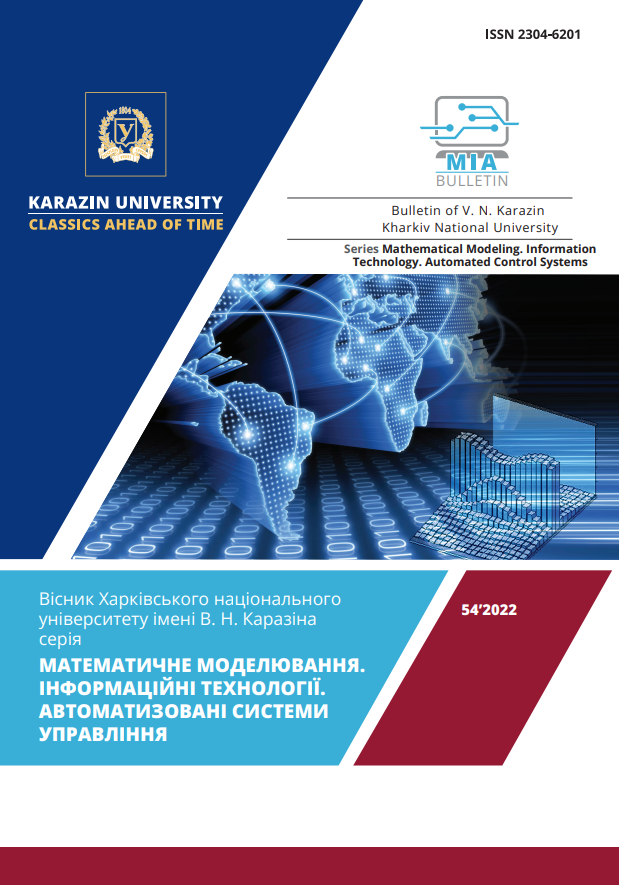Investigation of the dynamics of four waves covid-19 in European countries
Abstract
The peculiarities of the dynamics of successive waves of the covid-19 pandemic in Ukraine and other European countries have been considered by the methods of time series analyses. Both the oscillatory harmonic and growing non-harmonic dynamics have been detected. The curves of daily new cases of infected I(t), deceased D(t) and recovered R(t) individuals have been obtained from open sources and the mean and oscillating components have been identified. For the most countries the mean components of the curves I(t) and D(t) exhibit a small shift in 1-3 weeks that corresponds to the incubation period of the disease. The analysis of the spectrum of the oscillating components has showed that all countries have a fundamental harmonic with a period of T = 7 days, associated with the specifics of the working week of medical and statistical institutions. The rest of the harmonics in most countries turns out to have been close to zero, which corresponds to random errors in the collection of statistical data for the country's institutions. In a number of countries, signs of chaotic dynamics in the form of large amplitudes of neighboring harmonics and significant unexpected changes in the phase shifts between them have been revealed. Statistically reliable exponential approximations of the I(t) and D(t) curves at the stages of the fast and slow growth as well as fast and slow decrease in the number of cases for each of the four covid-19 waves in European countries have been obtained. The obtained approximations have been used for validation of the SEIRS mathematical model of the epidemic spread for a given country. The resulting country-specific models in the form of the systems of ordinary differential equations can be used for studying the dynamics of each wave in detail, and for predicting the further dynamics of covid-19 in the country.
Downloads
References
/References
N. Bacaër, A Short History of Mathematical Population Dynamics. Springer-Verlag, London. 2011. 160c.
D. Aldila, S.H.A. Khoshnaw, E. Safitri, et al. “A mathematical study on the spread of COVID-19 considering social distancing and rapid assessment: The case of Jakarta, Indonesia”, Chaos, Solitons and Fractals. 2020. Vol. 139, 110042. https://doi.org/10.1016/j.chaos.2020.110042
X. Duan, X. Zhang., “ARIMA modelling and forecasting of irregularly patterned COVID-19 outbreaks using Japanese and South Korean data”, Data in Brief. 2020. Vol. 31, 105779. htpps://doi.org/10.1016/j.dib.2020.105779
Q. Li, X. Guan, P. Wu, et al. “Early transmission dynamics in Wuhan, China, of novel coronavirus–infected pneumonia”, New England Journal of Medicine, 2020. Vol. 382, 1199-1207. htpps://doi.org/ 10.1056/NEJMoa2001316
M. Asadi-Zeydabadi, M. Buscema, W. Lodwick, et al. “Analysis of COVID-19 pandemic in USA, using Topological Weighted Centroid”, Computers in Biology and Medicine. 2021. Vol. 136, 104670. htpps://doi.org/ 10.1016/j.compbiomed.2021.104670
J. Sun, “Forecasting COVID-19 pandemic in Alberta, Canada using modifiedARIMA model”, Computer Methods and Programs in Biomedicine. 2021. Vol. 22, 100029. https://doi.org/10.1016/j.cmpbup.2021.100029
N. James, M. Menzies, “Trends in COVID-19 prevalence and mortality: A year in review”, Physica D. 2021. Vol. 425, 132968. https://doi.org/10.1016/j.physd.2021.132968
A. Zakharova, N. Kizilova, “Study on correlations of disease dynamics on COVID-19 with some socio-economic factors”, Bulletin of Kharkiv National University, series "Mathematical modeling. Information Technology. Automated control systems", 2020, Vol. 47, P.49-56. https://doi.org/10.26565/2304-6201-2020-48-04
V. Kostetzka, N. Kizilova, “ Mathematical modeling of the dynamics of the COVID-19 pandemic”, Bulletin of Kharkiv National University, series "Mathematical modeling. Information Technology. Automated control systems", 2020, Vol. 48, P.65-71. https://doi.org/10.26565/2304-6201-2020-48-06
M. Kermark, A. Mckendrick, “Contributions to the mathematical theory of epidemics”, Proceedings of the Royal Society London, 1927, v.115(5), P.700–721. https://doi.org/10.1098/rspa.1927.0118
Computational Modeling and Data Analysis in COVID-19 Research. Ed. by Ch.R.Panigrahi, B. Pati, M. Rath, R. Buyya. CRC Press. 2021.
Bacaër N. A Short History of Mathematical Population Dynamics. Springer-Verlag, London. 2011. 160c.
Aldila D., Khoshnaw S.H.A., Safitri E., et al. A mathematical study on the spread of COVID-19 considering social distancing and rapid assessment: The case of Jakarta, Indonesia. Chaos, Solitons and Fractals. 2020. Vol. 139, 110042. https://doi.org/10.1016/j.chaos.2020.110042
Duan X., Zhang X. ARIMA modelling and forecasting of irregularly patterned COVID-19 outbreaks using Japanese and South Korean data. Data in Brief. 2020. Vol. 31, 105779. htpps://doi.org/10.1016/j.dib.2020.105779
Li Q., Guan X., Wu P., et al. Early transmission dynamics in Wuhan, China, of novel coronavirus–infected pneumonia. New England Journal of Medicine, 2020. Vol. 382, 1199-1207. htpps://doi.org/ 10.1056/NEJMoa2001316
Asadi-Zeydabadi M., Buscema M., Lodwick W., et al. Analysis of COVID-19 pandemic in USA, using Topological Weighted Centroid. Computers in Biology and Medicine. 2021. Vol. 136, 104670. htpps://doi.org/ 10.1016/j.compbiomed.2021.104670
Sun J. Forecasting COVID-19 pandemic in Alberta, Canada using modifiedARIMA model. Computer Methods and Programs in Biomedicine. 2021. Vol. 22, 100029. https://doi.org/10.1016/j.cmpbup.2021.100029
James N., Menzies M. Trends in COVID-19 prevalence and mortality: A year in review. Physica D. 2021. Vol. 425, 132968. https://doi.org/10.1016/j.physd.2021.132968
Захарова А.А., Кізілова Н.М. Дослідження кореляцій динаміки захворювання на COVID-19 з деякими соціально-економічними факторами. Вісник Харківського національного університету серія «Математичне моделювання. Інформаційні технології. Автоматизовані системи управління». 2020. Вип. 47. С.49-56. https://doi.org/10.26565/2304-6201-2020-48-04
Костецька В.В., Кізілова Н.М. Математичне моделювання динаміки пандемії COVID-19. Вісник Харківського національного університету серія «Математичне моделювання. Інформаційні технології. Автоматизовані системи управління». 2020. Вип. 48. С.65-71. https://doi.org/10.26565/2304-6201-2020-48-06
Kermark M., Mckendrick A. Contributions to the mathematical theory of epidemics. Proceedings of the Royal Society London. 1927. v.115(5). P.700–721. https://doi.org/10.1098/rspa.1927.0118
Computational Modeling and Data Analysis in COVID-19 Research. Ed. by Ch.R.Panigrahi, B. Pati, M. Rath, R. Buyya. CRC Press. 2021.




